5-Chloroindoline-2,3-dione
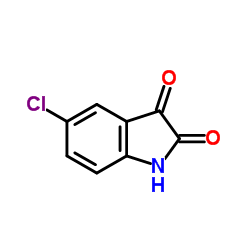
5-Chloroindoline-2,3-dione structure
|
Common Name | 5-Chloroindoline-2,3-dione | ||
|---|---|---|---|---|
| CAS Number | 17630-76-1 | Molecular Weight | 181.576 | |
| Density | 1.5±0.1 g/cm3 | Boiling Point | N/A | |
| Molecular Formula | C8H4ClNO2 | Melting Point | 254-258 °C(lit.) | |
| MSDS | Chinese USA | Flash Point | N/A | |
| Symbol |

GHS07 |
Signal Word | Warning | |
| Name | 5-Chloroisatin |
|---|---|
| Synonym | More Synonyms |
| Density | 1.5±0.1 g/cm3 |
|---|---|
| Melting Point | 254-258 °C(lit.) |
| Molecular Formula | C8H4ClNO2 |
| Molecular Weight | 181.576 |
| Exact Mass | 180.993057 |
| PSA | 46.17000 |
| LogP | 1.15 |
| Index of Refraction | 1.626 |
| InChIKey | XHDJYQWGFIBCEP-UHFFFAOYSA-N |
| SMILES | O=C1Nc2ccc(Cl)cc2C1=O |
| Water Solubility | insoluble |
Synonym: Section 2 - COMPOSITION, INFORMATION ON INGREDIENTS
Risk Phrases: None Listed. Section 3 - HAZARDS IDENTIFICATION EMERGENCY OVERVIEW
Not available. Potential Health Effects Eye: May cause eye irritation. Skin: May cause skin irritation. May be harmful if absorbed through the skin. Ingestion: May cause irritation of the digestive tract. May be harmful if swallowed. Inhalation: May cause respiratory tract irritation. May be harmful if inhaled. Chronic: Not available. Section 4 - FIRST AID MEASURES Eyes: Flush eyes with plenty of water for at least 15 minutes, occasionally lifting the upper and lower eyelids. Get medical aid. Skin: Get medical aid. Flush skin with plenty of water for at least 15 minutes while removing contaminated clothing and shoes. Ingestion: Get medical aid. Wash mouth out with water. Inhalation: Remove from exposure and move to fresh air immediately. Notes to Physician: Section 5 - FIRE FIGHTING MEASURES General Information: As in any fire, wear a self-contained breathing apparatus in pressure-demand, MSHA/NIOSH (approved or equivalent), and full protective gear. Extinguishing Media: Use water spray, dry chemical, carbon dioxide, or chemical foam. Section 6 - ACCIDENTAL RELEASE MEASURES General Information: Use proper personal protective equipment as indicated in Section 8. Spills/Leaks: Vacuum or sweep up material and place into a suitable disposal container. Section 7 - HANDLING and STORAGE Handling: Avoid breathing dust, vapor, mist, or gas. Avoid contact with skin and eyes. Storage: Store in a cool, dry place. Store in a tightly closed container. Section 8 - EXPOSURE CONTROLS, PERSONAL PROTECTION Engineering Controls: Use adequate ventilation to keep airborne concentrations low. Exposure Limits CAS# 17630-76-1: Personal Protective Equipment Eyes: Not available. Skin: Wear appropriate protective gloves to prevent skin exposure. Clothing: Wear appropriate protective clothing to prevent skin exposure. Respirators: Follow the OSHA respirator regulations found in 29 CFR 1910.134 or European Standard EN 149. Use a NIOSH/MSHA or European Standard EN 149 approved respirator if exposure limits are exceeded or if irritation or other symptoms are experienced. Section 9 - PHYSICAL AND CHEMICAL PROPERTIES Physical State: Solid Color: red - rust Odor: characteristic odor pH: Not available. Vapor Pressure: Not available. Viscosity: Not available. Boiling Point: Not available. Freezing/Melting Point: 247 deg C Autoignition Temperature: Not available. Flash Point: Not available. Explosion Limits, lower: Not available. Explosion Limits, upper: Not available. Decomposition Temperature: Solubility in water: Insoluble. Specific Gravity/Density: Molecular Formula: C8H4ClNO2 Molecular Weight: 181.4865 Section 10 - STABILITY AND REACTIVITY Chemical Stability: Stable. Conditions to Avoid: Incompatible materials. Incompatibilities with Other Materials: Oxidizing agents, reducing agents, bases. Hazardous Decomposition Products: Nitrogen oxides, carbon monoxide, carbon dioxide. Hazardous Polymerization: Has not been reported Section 11 - TOXICOLOGICAL INFORMATION RTECS#: CAS# 17630-76-1 unlisted. LD50/LC50: Not available. Carcinogenicity: 5-Chloroisatin - Not listed by ACGIH, IARC, or NTP. Section 12 - ECOLOGICAL INFORMATION Section 13 - DISPOSAL CONSIDERATIONS Dispose of in a manner consistent with federal, state, and local regulations. Section 14 - TRANSPORT INFORMATION IATA No information available. IMO No information available. RID/ADR No information available. Section 15 - REGULATORY INFORMATION European/International Regulations European Labeling in Accordance with EC Directives Hazard Symbols: Not available. Risk Phrases: Safety Phrases: S 24/25 Avoid contact with skin and eyes. WGK (Water Danger/Protection) CAS# 17630-76-1: No information available. Canada None of the chemicals in this product are listed on the DSL/NDSL list. CAS# 17630-76-1 is not listed on Canada's Ingredient Disclosure List. US FEDERAL TSCA CAS# 17630-76-1 is not listed on the TSCA inventory. It is for research and development use only. SECTION 16 - ADDITIONAL INFORMATION N/A |
| Symbol |

GHS07 |
|---|---|
| Signal Word | Warning |
| Hazard Statements | H315-H319-H335 |
| Precautionary Statements | P261-P305 + P351 + P338 |
| Personal Protective Equipment | dust mask type N95 (US);Eyeshields;Gloves |
| Hazard Codes | Xi:Irritant |
| Risk Phrases | R36/37/38 |
| Safety Phrases | S26-S36 |
| RIDADR | NONH for all modes of transport |
| WGK Germany | 3 |
| HS Code | 2933990090 |
| Precursor 10 | |
|---|---|
| DownStream 10 | |
| HS Code | 2933990090 |
|---|---|
| Summary | 2933990090. heterocyclic compounds with nitrogen hetero-atom(s) only. VAT:17.0%. Tax rebate rate:13.0%. . MFN tariff:6.5%. General tariff:20.0% |
|
Synthesis, Characterization and Biological Activities of a New 5-Chloroisatin Schiff Base and its Metal Complexes. RAO R, et al.
Chem. Sci. Trans. 2(3) , 1063-1069, (2013)
|
|
|
Synthesis of Schiff and Mannich bases of isatin derivatives with 4-amino-4,5-dihydro-1H-1,2,4-triazole-5-ones.
Molecules 13(9) , 2126-35, (2008) Ethyl imidate hydrochlorides 1 were prepared by passing HCl gas through solutions of substituted benzyl cyanides and absolute ethanol. Ethoxycarbonylhydrazones 2 were synthesized from the reaction of ... |
| 5-Chloroisatin |
| 1H-Indole-2,3-dione, 5-chloro- |
| EINECS 241-614-0 |
| MFCD00014567 |
| 5-Chloroindoline-2,3-dione |
| 5-Chloro-1H-indole-2,3-dione |
 CAS#:302-17-0
CAS#:302-17-0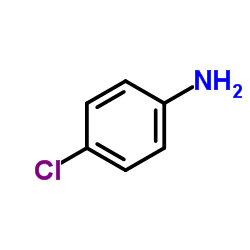 CAS#:106-47-8
CAS#:106-47-8 CAS#:65798-06-3
CAS#:65798-06-3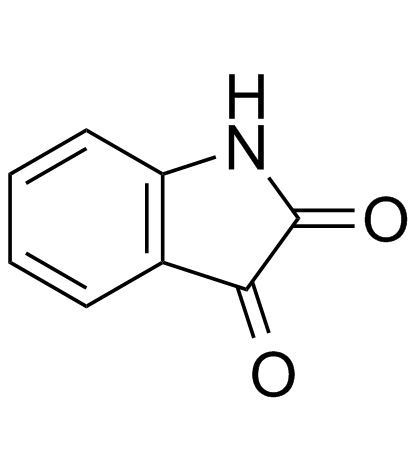 CAS#:91-56-5
CAS#:91-56-5 CAS#:17422-32-1
CAS#:17422-32-1 CAS#:79-37-8
CAS#:79-37-8 CAS#:85124-16-9
CAS#:85124-16-9 CAS#:113423-48-6
CAS#:113423-48-6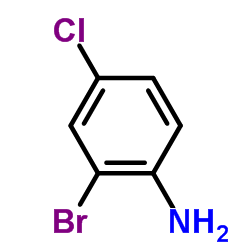 CAS#:873-38-1
CAS#:873-38-1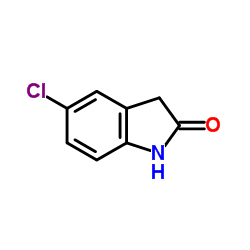 CAS#:17630-75-0
CAS#:17630-75-0 CAS#:35166-78-0
CAS#:35166-78-0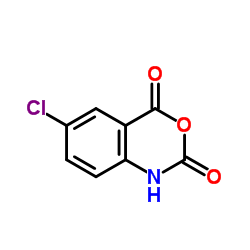 CAS#:4743-17-3
CAS#:4743-17-3 CAS#:33289-51-9
CAS#:33289-51-9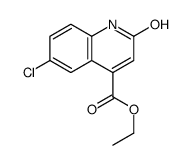 CAS#:199179-57-2
CAS#:199179-57-2 CAS#:202288-38-8
CAS#:202288-38-8 CAS#:118-75-2
CAS#:118-75-2 CAS#:874-17-9
CAS#:874-17-9 CAS#:932-31-0
CAS#:932-31-0 CAS#:6633-62-1
CAS#:6633-62-1 CAS#:635-21-2
CAS#:635-21-2
